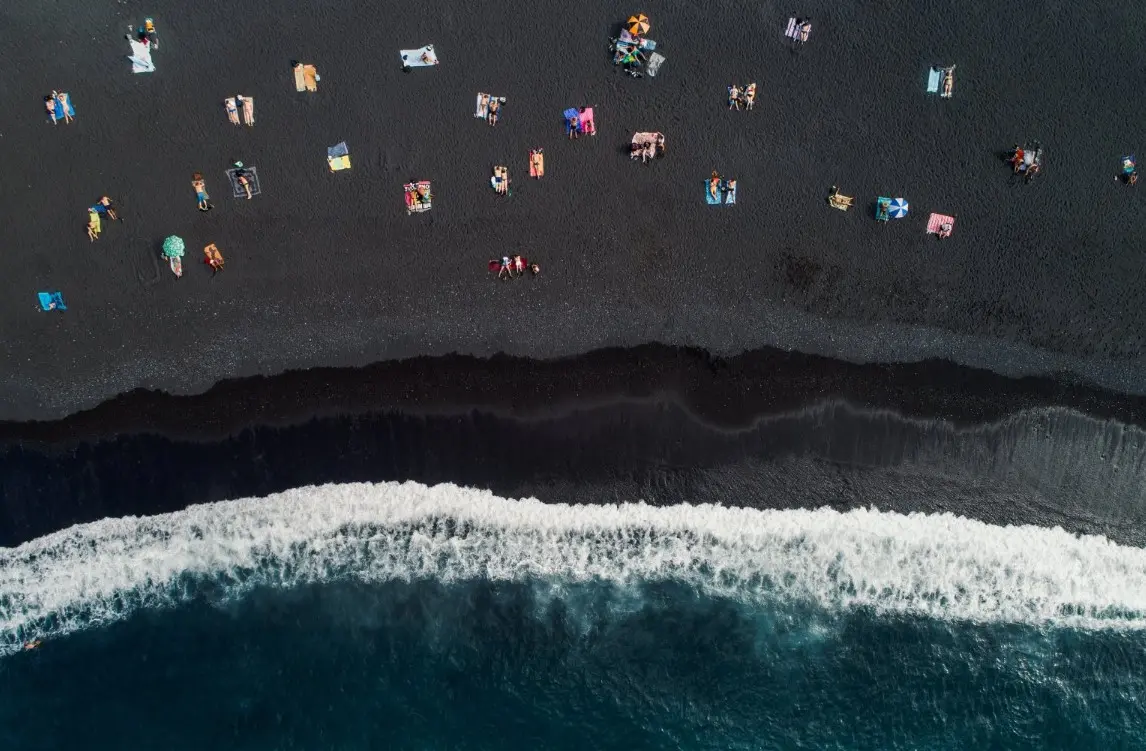What Are Black Sand Beaches?
Black sand beaches are mesmerizing natural formations that draw attention with their striking appearance. These beaches result from volcanic activity, a testament to the Earth’s dynamic and fiery past. As molten lava flows from the earth’s core and meets the cool embrace of the ocean on a beach, it rapidly solidifies and shatters into minuscule fragments that accumulate to form the dark sand of these unique coastlines. Found primarily in volcanic regions such as Hawaii, known for its idyllic beaches, the rugged coasts of Iceland, and the exotic shores of New Zealand, each black sand beach tells a distinct story of the constant interplay between fire and water that shapes our planet.
These geological formations offer more than just visual allure; they provide insights into the planet’s volcanic processes that have been at work for millions of years. The formation of black sand beaches is a powerful reminder of the transformative power of natural forces, highlighting how nature’s destructive and creative aspects are inextricably linked.
Geological Wonders
Black sand beaches stand as testimonies to Earth’s geological wonders. Their grains often comprise volcanic minerals and rocks like basalt, labradorite, and sometimes even olivine and semi-precious stones, creating a mosaic of natural history at our feet. These minerals, each with its dark, mysterious hue, are clues to the volcanic origins of the beaches and offer invaluable information for scientists and curious visitors. The composition and formation of black sand beaches also vary by region, reflecting the unique volcanic activity and environmental conditions that shaped them over time.
The visual and geological contrasts are stark and compelling in places like Iceland, where icy glaciers converge with these dark sandy shores. The island’s unique positioning on the Mid-Atlantic Ridge, where tectonic plates meet, makes it a living classroom for studying geothermal phenomena. Here, one can observe firsthand the results of Earth’s geothermal energy and how past volcanic activities shape today’s landscapes. For geologists, these beaches offer a fascinating puzzle, piecing together past eruptions and erosion patterns to understand the continuous shaping of the Earth’s surface.
Stunning Visual Contrasts
The aesthetic charm of black sand beaches is unmatched. Their deep, dark sands contrast the vivid blues of the ocean waves and the sky above. This natural scenery is enhanced further by surrounding lush greenery and sometimes even stark white icebergs, depending on the location, creating a breathtaking kaleidoscope of colors.
For photographers and artists, black sand beaches are a source of endless inspiration. The striking contrast between the surf’s foamy white caps and the obsidian sands below crafts a visual elegance that draws creative souls worldwide. This unique interplay of light and dark, earth and water, provides a natural backdrop that stimulates the imagination and invites new perspectives on nature’s artistry, offering vivid scenes that appear almost otherworldly.
Unique Ecosystems
Beneath the beauty and allure of black sand beaches lies a complex and fragile ecosystem teeming with life. These areas, abundant with volcanic rock nutrients, support various plant species uniquely adapted to thrive in harsh conditions. This vegetation can include robust grasses and unique shrubs that tough out the saline winds and nutrient-rich sands.
The ecosystems extend beyond the shore and into the coastal waters. The stability provided by the mineral-rich sand supports marine life forms not commonly found elsewhere. This includes certain species of fish and crustaceans that have adapted to the specific conditions around black sand beaches. These environments offer researchers a closer look at adaptability and biodiversity, providing a living laboratory to study ecological resilience and evolutionary processes. The lessons learned from these thriving ecosystems can inform broader ecological and conservation strategies, emphasizing the importance of protecting these vibrant habitats.
Tourism and Serenity
Black sand beaches are a visual spectacle and a serene getaway, drawing visitors seeking adventure and peace. Their isolated locations, away from the bustling crowds of more commercial beaches, offer a peaceful retreat where one can reconnect with nature. Visitors describe these beaches’ profound stillness and beauty as therapy for the mind and soul.
This serenity is a major draw for eco-tourism and wellness retreats, which promote sustainable travel that respects and preserves the natural beauty of these environments. Such practices benefit the ecosystem and provide cultural and economic benefits to local communities. Travelers to black sand beaches contribute to the development of sustainable tourism initiatives that aim to maintain the natural charm of these destinations for generations to come.
Precautions and Safety Tips
Despite their allure, black sand beaches can challenge the unprepared visitor. The terrain, while picturesque, often proves unstable and may shift unexpectedly, particularly near the water’s edge. Additionally, tides here can be treacherous, changing rapidly and without warning.
Visitors should heed local advice and respect warning signs to enjoy these beaches safely. It’s crucial to remain informed about local weather conditions and avoid venturing into restricted areas. Another important aspect of visiting these beaches is practicing environmental responsibility. Tourists should minimize their environmental footprint—avoid removing sand or rocks, respect wildlife habitats, and dispose of any waste. Such actions ensure the preservation of these natural wonders so they can continue to inspire awe in those who visit them.
Final Thoughts
Black sand beaches encapsulate nature’s beauty and power, offering landscapes that challenge our understanding of the world. Their captivating beauty, rich geological history, and unique ecosystems make them invaluable natural treasures. By appreciating and preserving these special places, we honor nature’s artistry and foster a lasting connection with the environment.
Also Read-The Benefits and Science Behind Skin Brightening Treatments

